INSTITUT SUPERIEUR D'ANTHROPOLOGIE
INSTITUTE OF ANTHROPOLOGY
ONLINE COURSES / COURS A DISTANCE
FALL TERM : OCTOBER 2014
REGISTER NOW
PEROU – 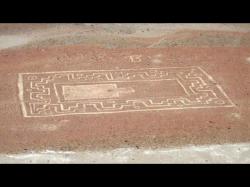 Arequipa - Archaeologists undertaking investigations in the Peruvian region of Arequipa discovered a large geoglyph last December. According to Peru21, the geoglyph is approximately 60 meters by 40 meters and is located in the province of Caylloma. Peru21 reports that the initial archaeological investigations were performed at the request of the Consorcio Angostura – Siguas, an agroindustrial company that is executing an irrigation project in the area. Consorcio Angostura – Siguas would have ordered the investigation in order to receive a certificate from the Ministry of Culture stating that there were no archaeological sites in the area, allowing them to continue with their irrigation project. Experts say that the geoglyph was created by members of the Wari culture in 1200 or 1300 AD. The geoglyph has been dubbed “Gross Munsa,” and is the only known geoglyph in Arequipa. Peru21 reports that excavators also found other objects that they hope will help to shed some light on Wari culture and practices.
Arequipa - Archaeologists undertaking investigations in the Peruvian region of Arequipa discovered a large geoglyph last December. According to Peru21, the geoglyph is approximately 60 meters by 40 meters and is located in the province of Caylloma. Peru21 reports that the initial archaeological investigations were performed at the request of the Consorcio Angostura – Siguas, an agroindustrial company that is executing an irrigation project in the area. Consorcio Angostura – Siguas would have ordered the investigation in order to receive a certificate from the Ministry of Culture stating that there were no archaeological sites in the area, allowing them to continue with their irrigation project. Experts say that the geoglyph was created by members of the Wari culture in 1200 or 1300 AD. The geoglyph has been dubbed “Gross Munsa,” and is the only known geoglyph in Arequipa. Peru21 reports that excavators also found other objects that they hope will help to shed some light on Wari culture and practices.
http://www.peruthisweek.com/news-wari-geoglyph-found-in-southern-peru-103545
ROYAUME UNI – 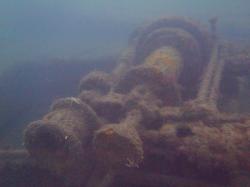 Scapa Flow- A report on an underwater archaeology survey in Scapa Flow has shed new light on the extent, survival, and condition of some of the Flow’s lesser known First and Second World War wreck sites. The work was carried out between October 2013 and March 2014 by ORCA Marine and SULA Diving, on behalf of Historic Scotland, and the results have recently been published on the www.scapaflowwrecks.com website. The team made a new discovery at the Churchill Barriers, and addressed some confusion over the identity of some of the blockships. The wreck of the SS Clio II was mapped for the first time, east of Barrier 3, and her identity confirmed against Admiralty Records from WW1. Previous records had indicated that nothing remained of the WW1 blockships SS Rosewood and SS Minieh,but these sites were also identified and mapped.
Scapa Flow- A report on an underwater archaeology survey in Scapa Flow has shed new light on the extent, survival, and condition of some of the Flow’s lesser known First and Second World War wreck sites. The work was carried out between October 2013 and March 2014 by ORCA Marine and SULA Diving, on behalf of Historic Scotland, and the results have recently been published on the www.scapaflowwrecks.com website. The team made a new discovery at the Churchill Barriers, and addressed some confusion over the identity of some of the blockships. The wreck of the SS Clio II was mapped for the first time, east of Barrier 3, and her identity confirmed against Admiralty Records from WW1. Previous records had indicated that nothing remained of the WW1 blockships SS Rosewood and SS Minieh,but these sites were also identified and mapped.
http://www.orcadian.co.uk/2014/07/wrecks-under-the-spotlight/
TURQUIE – 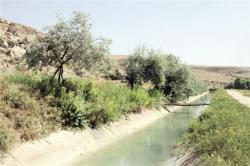
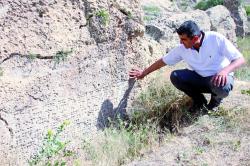 Van - 3,000 year-old and 51-kilometer-long water channel, which was constructed at the time of the Urartian Kingdom and considered a wonder of engineering, will be used to attract tourism to Van. Constructed by the Urartian King Menua in the eastern province of Van’s Gürpınar district to carry water to the city center, the Şamran channel is one of the most important surviving pieces of architecture by the Urartian Kingdom. The Yüzüncü Yıl University (YYÜ) Archaeology Department Associate Professor Rafet Çavuşoğlu said some of the large rocks in the area were carved up and used to build the channel and that agriculture had developed in the region thanks to the water carried by the channel. He said that Urartian documents used to call the channel “Menua,” but the name eventually changed to Şaman, adding: “Armenian historian Movses mentions that the name Şamzran is after the Assyrian queen Semiramis.” According to Çavuşoğlu’s research, after the Urartian cuneiform was deciphered, the water channel was built by the Urartian King Menua in order to irrigate the Van plains. “After the Urartians, the queen Semiramis rebuilt the channel with her 42,000 workers, according to resources,” he said, adding that the Urartian king Menua’s wife Tariri had a garden in today’s Edremit’s “Green Valley,” which was watered by the Şamran channel.
Van - 3,000 year-old and 51-kilometer-long water channel, which was constructed at the time of the Urartian Kingdom and considered a wonder of engineering, will be used to attract tourism to Van. Constructed by the Urartian King Menua in the eastern province of Van’s Gürpınar district to carry water to the city center, the Şamran channel is one of the most important surviving pieces of architecture by the Urartian Kingdom. The Yüzüncü Yıl University (YYÜ) Archaeology Department Associate Professor Rafet Çavuşoğlu said some of the large rocks in the area were carved up and used to build the channel and that agriculture had developed in the region thanks to the water carried by the channel. He said that Urartian documents used to call the channel “Menua,” but the name eventually changed to Şaman, adding: “Armenian historian Movses mentions that the name Şamzran is after the Assyrian queen Semiramis.” According to Çavuşoğlu’s research, after the Urartian cuneiform was deciphered, the water channel was built by the Urartian King Menua in order to irrigate the Van plains. “After the Urartians, the queen Semiramis rebuilt the channel with her 42,000 workers, according to resources,” he said, adding that the Urartian king Menua’s wife Tariri had a garden in today’s Edremit’s “Green Valley,” which was watered by the Şamran channel.
http://www.hurriyetdailynews.com/channel-built-by-urartian-king-to-serve-van-tourism.aspx?pageID=238&nID=69710&NewsCatID=375
USA – Cortez - Ancient ruins at the site of the new Montezuma-Cortez High School have been stabilized and untouched, according to archaeological officials.Last year, Woods Canyon Archaeological Consultants surveyed the ruins, which is behind Wal-mart. The site was remapped prior to design and construction of the new Montezuma-Cortez High School. Under authority of State of Colorado permit 2013-23, Fetterman led three archaeologists and nine volunteers to conduct a cultural resources investigation of the 100-square-foot site in April 2013. The Montezuma-Cortez Re-1 School District chose to preserve the site in its natural condition. “There was no excavation of the site,” said Fetterman. Located on the northeast corner of the new school site, the ancient ruins include a pueblo and evidence of a chipping station, a place where stone tools were made, according to Fetterman.
http://www.cortezjournal.com/article/20140728/NEWS01/140729840/Ruins-stabilized-at-M-CHS-site-
GRECE –  Franchthi Cave - In Greek waters for the next few weeks, the Tûranor PlanetSolar, the world's largest solar-powered boat, relies on 8.5 tons of lithium-ion batteries in and can reach speeds of up to 14 knots. The world's largest solar-powered boat is continuing its journey to the western Peloponnese where it will take part in an underwater archaeological project focused on one of Europe's oldest human occupation sites, the Franchthi cave, near Ermioni in Argolida. The TerraSubmersa archaeology project, run by a joint Greek-Swiss team, will explore the underwater terrain to identify a prehistoric village near Franchthi, a cave in continuous occupation for about 35,000 years, from Paleolithic to Neolithic times. The project is taking place in one of Greece's richest archaeological areas, Argolida (or the Argolid), known for its major palatial complexes in the Bronze Age that include Mycenae and Tiryns and later, classical-era city-states and sites like Argos and the ancient-theatre site of Epidaurus. The PlanetSolar will act as a laboratory base from August 18 to September 12, with staff carrying out geophysical measurements to reconstruct the original, above-water, topography of the area before it submerged.At the end of the last ice age, around 20,000 years ago, sea level was considerably lower than it is today. By studying these submerged prehistoric landscapes, archaeologists can reconstitute the environments that have disappeared underwater and comprehend the interactions between prehistoric man and the sea. These studies, which are likely to become one of the major archaeological challenges of the 21st century, will enable to identify the mechanisms of population settlement in coastal areas.
Franchthi Cave - In Greek waters for the next few weeks, the Tûranor PlanetSolar, the world's largest solar-powered boat, relies on 8.5 tons of lithium-ion batteries in and can reach speeds of up to 14 knots. The world's largest solar-powered boat is continuing its journey to the western Peloponnese where it will take part in an underwater archaeological project focused on one of Europe's oldest human occupation sites, the Franchthi cave, near Ermioni in Argolida. The TerraSubmersa archaeology project, run by a joint Greek-Swiss team, will explore the underwater terrain to identify a prehistoric village near Franchthi, a cave in continuous occupation for about 35,000 years, from Paleolithic to Neolithic times. The project is taking place in one of Greece's richest archaeological areas, Argolida (or the Argolid), known for its major palatial complexes in the Bronze Age that include Mycenae and Tiryns and later, classical-era city-states and sites like Argos and the ancient-theatre site of Epidaurus. The PlanetSolar will act as a laboratory base from August 18 to September 12, with staff carrying out geophysical measurements to reconstruct the original, above-water, topography of the area before it submerged.At the end of the last ice age, around 20,000 years ago, sea level was considerably lower than it is today. By studying these submerged prehistoric landscapes, archaeologists can reconstitute the environments that have disappeared underwater and comprehend the interactions between prehistoric man and the sea. These studies, which are likely to become one of the major archaeological challenges of the 21st century, will enable to identify the mechanisms of population settlement in coastal areas.
http://www.enetenglish.gr/?i=news.en.society&id=2041
BULGARIE – 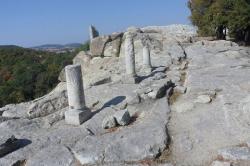 Perperikon - The archaeological excavations of the Thracian city of Perperikon, located in Bulgaria's Eastern Rhodopes will start on August 4, professor Nikolay Ovcharov announced. Ovcharov, who heads the research team, stated that this year the State has allocated BGN 80 thousand for the excavations at Perperikon, while the needed funding amounts to BGN 200 thousand. The research campaign will begin now and will continue till October - November, Ovcharov explained, adding that his team will explore the eastern part of the Acropolis, however most likely the time will not be enough and the work will continue in 2015, Darik news informs. This year the group of archaeologists is made up of 35 people, provided that so far there have always been about 80-90 people, Ovcharov said. In addition to Perperikon, research will be carried out in the ancient city of Misionis near Targovishte, where Ovcharov expects to find town planning similar to that in Perperikon. The funds allocated for the site this year run up to BGN 70 thousand.
Perperikon - The archaeological excavations of the Thracian city of Perperikon, located in Bulgaria's Eastern Rhodopes will start on August 4, professor Nikolay Ovcharov announced. Ovcharov, who heads the research team, stated that this year the State has allocated BGN 80 thousand for the excavations at Perperikon, while the needed funding amounts to BGN 200 thousand. The research campaign will begin now and will continue till October - November, Ovcharov explained, adding that his team will explore the eastern part of the Acropolis, however most likely the time will not be enough and the work will continue in 2015, Darik news informs. This year the group of archaeologists is made up of 35 people, provided that so far there have always been about 80-90 people, Ovcharov said. In addition to Perperikon, research will be carried out in the ancient city of Misionis near Targovishte, where Ovcharov expects to find town planning similar to that in Perperikon. The funds allocated for the site this year run up to BGN 70 thousand.
http://www.novinite.com/articles/162338/Bulgaria%27s+Ancient+City+of+Perperikon+Excavations+Funding+Trimmed
IRLANDE – 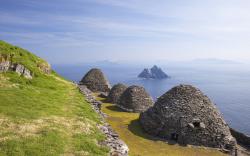 Skellig Michael - UNESCO has enquired about whether appropriate authorisation was granted for the use of World Heritage site Skellig Michael as a film set for the latest instalment in the Star Wars franchise. Skellig Michael is an island off the coast of County Kerry and features a Christian monastery founded at some point between the 6th and 8th centuries. The remains of this monastery, along with most of the island itself, were added to the World Heritage Site list in 1996. In addition to UNESCO, both Birdwatch Ireland and an independent archaeologist had expressed concerns about the impact of a major film crew on a fragile environment such as the monastery.
Skellig Michael - UNESCO has enquired about whether appropriate authorisation was granted for the use of World Heritage site Skellig Michael as a film set for the latest instalment in the Star Wars franchise. Skellig Michael is an island off the coast of County Kerry and features a Christian monastery founded at some point between the 6th and 8th centuries. The remains of this monastery, along with most of the island itself, were added to the World Heritage Site list in 1996. In addition to UNESCO, both Birdwatch Ireland and an independent archaeologist had expressed concerns about the impact of a major film crew on a fragile environment such as the monastery.
http://www.leisuremanagement.co.uk/detail.cfm?pagetype=detail&subject=news&codeID=310522